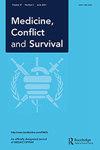佩戴红十字的矛盾心理。
Q3 Medicine
Medicine, Conflict and Survival
Pub Date : 2024-09-01
Epub Date: 2024-05-27
DOI:10.1080/13623699.2024.2353180
引用次数: 0
摘要
本文根据对原始资料的研究,描述并分析了澳大利亚军队担架员和医护人员佩戴红十字会胸牌的经历。这一人道主义标志旨在确保从事人道主义工作的人员的安全。在冲突地区佩戴红十字的人员的证词表明,他们认为佩戴红十字会使他们容易受到攻击,他们认为不佩戴红十字会更安全。本文比较了第一次世界大战中担架员的经历和当代阿富汗战争中医护人员的经历。本文章由计算机程序翻译,如有差异,请以英文原文为准。
The ambivalence of wearing the Red Cross.
This article, based on research into primary sources, describes and analyses the experiences of Australian Army stretcher-bearers and medics who wear the Red Cross brassard. This humanitarian symbol is supposed to ensure the safety of personnel engaged in humanitarian work. The testimonies of those who wear the Red Cross, in fields of conflict, show that they believe it makes them vulnerable to attack and that they believe themselves to be safer without it. This article compares the experiences of stretcher-bearers in World War One, and that of medics in the more contemporary War in Afghanistan.
求助全文
通过发布文献求助,成功后即可免费获取论文全文。
去求助
来源期刊

Medicine, Conflict and Survival
Medicine-Pathology and Forensic Medicine
CiteScore
1.80
自引率
0.00%
发文量
46
期刊介绍:
Medicine, Conflict and Survival is an international journal for all those interested in health aspects of violence and human rights. It covers: •The causes and consequences of war and group violence. •The health and environmental effects of war and preparations for war, especially from nuclear, radiological, chemical and biological weapons of mass destruction. •The influence of war and preparations for war on health and welfare services and the distribution of global resources . •The abuse of human rights, its occurrence, causes and consequences. •The ethical responsibility of health professionals in relation to war, social violence and human rights abuses. •Non-violent methods of conflict resolution.
 求助内容:
求助内容: 应助结果提醒方式:
应助结果提醒方式:


